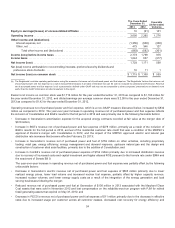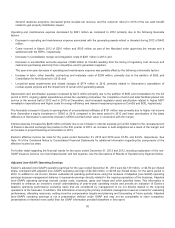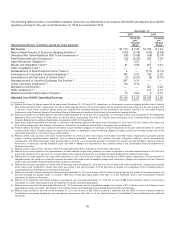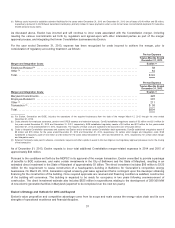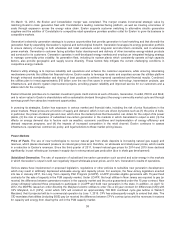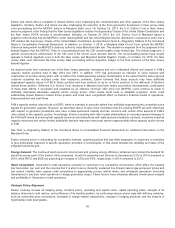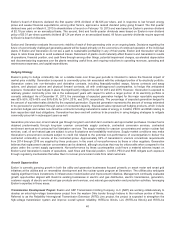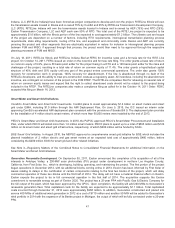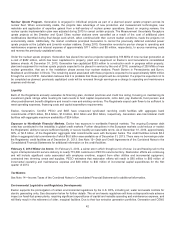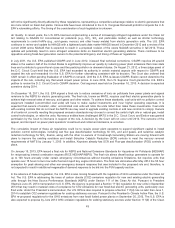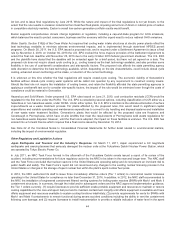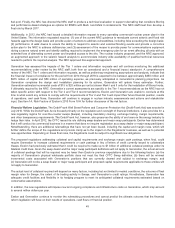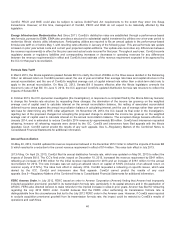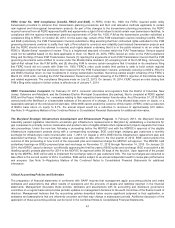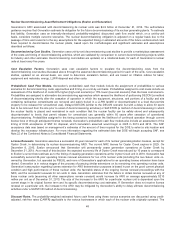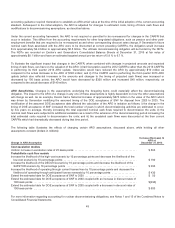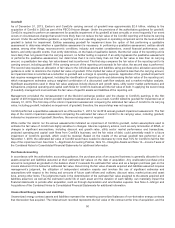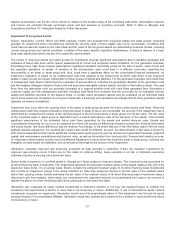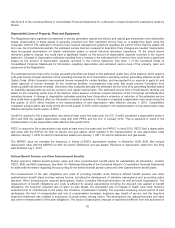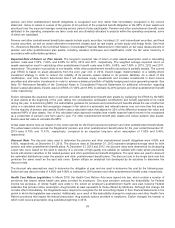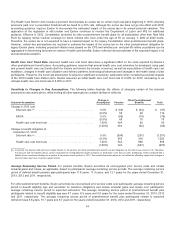ComEd 2013 Annual Report Download - page 50
Download and view the complete annual report
Please find page 50 of the 2013 ComEd annual report below. You can navigate through the pages in the report by either clicking on the pages listed below, or by using the keyword search tool below to find specific information within the annual report.AirAct,andto issue final regulationsbyJune 2015. While the nature andimpactofthefinal regulationsisnot yet known,to the
extent that the rule resultsinemission reductionsfromfossilfuel firedplants, imposingsomeformofdirectorindirectpriceofcarbon
incompetitive electricitymarkets, Exelon’s overall low-carbon generation portfolioresultswouldbenefit.
Exelon supportscomprehensiveclimate changelegislation or regulation,includingacap-and-trade programfor GHG emissions,
which balancesthe needto protectconsumers, business andtheeconomy withtheurgent needto reduce national GHG emissions.
Water Quality. Section 316(b) oftheClean Water Actrequiresthat coolingwater intakestructuresat electric power plantsreflectthe
besttechnology available to minimizeadverseenvironmental impacts, andisimplementedthrough state-level NPDES permit
programs. OnMarch 28, 2011,theU.S. EPAissueda proposedrule,andisrequiredunder a Settlement Agreement to issue a final
rule by November 4, 2013;on October 30,2013 theU.S. EPAinvokedtheforce majeure provision oftheSettlement Agreement to
extendthefinal rule deadline untilNovember 20,2013 due to the earlyOctober 2013 federal government shutdown.TheU.S. EPA
andthe plaintiffs havestatedthat thedeadline will beextendedagainfor a briefperiod, but have not yet agreedon a date.The
proposedrule doesnot require closed cycle cooling(e.g., coolingtowers) asthebesttechnology available,andalso providessome
flexibilityintheuseofcost-benefitconsiderationsandsite-specific factors. The proposedrule affords thestate permittingagency
widediscretion to determine thebesttechnology available, which, dependingon thesite characteristics, couldincludeclosed cycle
cooling, advancedscreen technology at theintake,or retention ofthecurrent technology.
Itis unknownatthis timewhether thefinal regulationswill require closed-cycle cooling. Theeconomic viabilityofGeneration’s
facilitieswithout closed-cycle coolingwater systems will becalledinto question by anyrequirement to constructcoolingtowers.
Shouldthefinal rule not require theinstallation ofcoolingtowers, andretaintheflexibilityaffordedthestate permittingagenciesin
applyingacost-benefittestandto consider site-specific factors, theimpactofthe rule wouldbeminimizedeven though thecostsof
compliancecouldbematerial to Generation.
Hazardous and Solid Waste. Under proposed U.S. EPA rules issuedon June 21,2010,coal combustion residuals (CCR)wouldbe
regulatedfor thefirsttimeunder theRCRA.TheU.S. EPAis consideringseveral options, includingclassification ofCCReither asa
hazardousor non-hazardouswaste,under RCRA.Under either option,theU.S. EPA’s intention is the ultimate elimination ofsurface
impoundmentsasawaste treatment process. For plantsaffectedbythe proposedrules, this wouldresult insignificant capital
expendituresandvariable operatingandmaintenanceexpendituresto convert to dryhandlingand disposal systems andinstallation
ofnewwaste water treatment facilities. Generation’s plantsthat wouldbeaffectedbythe proposedrulesare Keystone and
Conemaugh inPennsylvania, which haveon-site landfillsthat meet therequirementsofPennsylvaniasolid waste regulationsfor
non-hazardouswaste disposal.However,untilthefinal rule is adopted, theimpactonthesefacilitiesisunknown.TheU.S. EPAhas
enteredinto a Consent Decree which requiresthat a final rule beissuedbyDecember 19, 2014.
See Note 22 oftheCombinedNotesto ConsolidatedFinancial Statementsfor further detail relatedto environmental matters,
includingtheimpactofenvironmental regulation.
Other Regulatory and Legislative Actions
Japan Earthquake and Tsunami and the Industry’s Response. OnMarch 11,2011,Japan experienceda9.0magnitude
earthquakeandensuingtsunami that seriouslydamagedthenuclear unitsat theFukushimaDaiichi Nuclear Power Station, which
are operatedbyTokyoElectric Power Co.
InJuly2011,an NRCTask ForceformedintheaftermathoftheFukushimaDaiichi events issueda report ofitsreviewofthe
accident,includingrecommendationsfor future regulatoryaction by theNRCto betaken inthe near andlonger term. TheNRCstaff
andtheTask Forceconcludedthat nuclear reactorsintheUnitedStatesare operatingsafelyanddo not present an imminent risk to
public healthandsafety. TheTask Force’s report did not recommendanychangesto theexistingnuclear licensingprocess inthe
UnitedStatesor changesinthestorageofspent nuclear fuel withinthe plant’s spent nuclear fuel pools.
In 2012,theNRCauthorizeditsstaff to issue three immediatelyeffectiveorders (Tier 1 orders) to commercial reactor licensees
operatingintheUnitedStatesfor compliance no later than December 31,2016. Inaddition,in 2012,theNRCstaff recommendedto
theNRCtheinstallation ofengineeredcontainment filteredventing systems for boiling-water reactors (BWR)withMarkIandMarkII
containment structures. Insummary, through theinitial and/or subsequent ordersandtheNRCapprovedimplementation guidance,
theTier 1 orderscurrently: (1)require licenseesto providesufficient onsite portable equipment andresourcesto maintainorrestore
coolingcapabilitiesfor thecore andspent fuel pool andto maintaincontainment integrityuntiloffsite equipment is available andhave
offsite equipment andresourcesavailable to sustaincoolingfunctionsindefinitely; (2)providerequirementsfor ventsfor BWR’s with
MarkIandMarkIIcontainmentsto remainfunctional duringsevere accident conditionsincludingtheabilityto vent thecontainment
followingcore damage;and(3)require licenseesto install instrumentation to provide a reliable indication ofwater level inthespent
44


